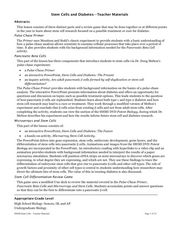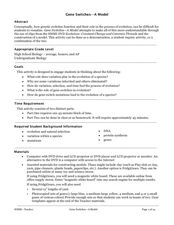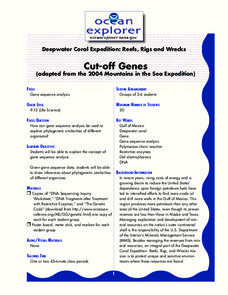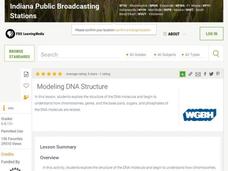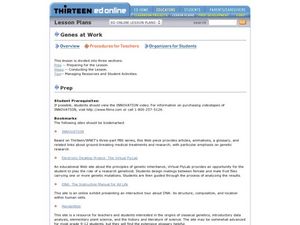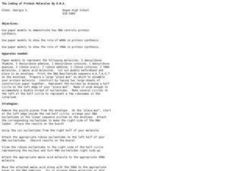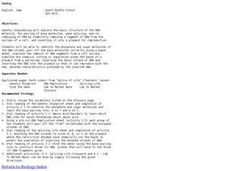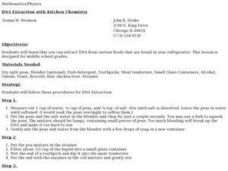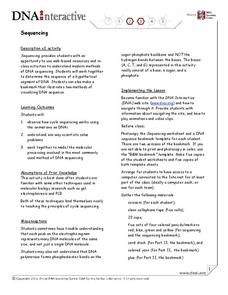Curated OER
Parental Genes
Eighth graders explore how different organisms pass their traits to their offspring. In this life science lesson, 8th graders differentiate recessive and dominant alleles. They predict the phenotype based on the genotype of an organism.
Curated OER
Birth of the Earth
Middle schoolers examine the major events that have taken place in the Earth's development. In this Earth activity students view a video and put major events in chronological order.
Howard Hughes Medical Institute
Stem Cells and Diabetes
Learners investigate stem cells. In this science instructional activity, students discuss stem cells and view a video about human embryonic development. Learners conduct the pulse-chase.
Curated OER
Gene Switches- A Model
Students explore genetic variation within a population. In this genetic adaptation lesson, students investigate the reasons contributing to genetic adaptation. Students collaborate and analyze DNA models. Multiple resources are provided.
Curated OER
How Big is a Gene?
Learners model the size and structure of a bacterial chromosome. In this genetics lesson, students attempt to fit strands of thread into a gelatin capsule. They relate the activity to the coiling of DNA into chromosomes in a bacterium.
Curated OER
Cut-Off Genes
Young scholars explain the concept of gene sequence analysis. In this gene lesson, students draw inferences about phylogenetic similarities of different organisms.
Curated OER
Modeling DNA Structure
Students build their own DNA molecules using candy. In this science lesson, students build DNA molecules using licorice and gumdrops. The lesson includes the use of streaming videos from the teacher's domain.
Curated OER
Genes at Work
Students explore and discuss genetics stories and answer questions about genetic outcomes of offspring. In this genetics lesson, students read genetics stories on a web site. Students use a chart to answer questions regarding the...
Curated OER
The Coding of Protein Molecules by DNA
Students investigate the production of proteins by the DNA. In this protein synthesis lesson plan, students use paper models to explore transcription and translation to make proteins using DNA. Students answer 10 questions to demonstrate...
Curated OER
Biology Trivia Questions
Students answer 71 questions about a variety of topics in biology. In this biology trivia lesson plan, students use the internet to find the answer to questions about the systems of the body, their structures and functions, the different...
Curated OER
GenEng
Students investigate the process of genetic engineering. In this genetic engineering lesson plan, students use paper models of DNA and plasmid bacterium to investigate the process of replicating DNA, splicing genes from DNA, and...
Curated OER
DNA Extraction with Kitchen Chemistry
Students extract DNA from green peas. In this DNA extraction lesson plan, students use a blender to chop up peas, they mix them with a little soap, they tenderize them and they mix them with alcohol to see the DNA precipitate through the...
Curated OER
Standard 4 Review Sheet-Genetics and Inheritance
In this genetics worksheet, students answer a variety of questions about inheritance, DNA, the genetic code, genes, sexual and asexual reproduction, mutations, protein synthesis and genetic engineering.
Curated OER
Standard 4 Review Sheet-Key Ideas Biology-The Living Environment
In this living environment worksheet, students answer a variety of questions about living organisms, the processes they go through to make food and break down food, absorb nutrients, and release toxins. They explain homeostasis, they...
Curated OER
DNA/Genetics
Students delve into a study of DNA. In this science lesson plan, students gain an understanding of DNA, which is the genetic material for every person and every other living thing.
Curated OER
Groovy DNA Beads
Learners create models of DNA and RNA using string and beads. They use beads representing the four nitrogenous bases of DNA to create a portion of a strand of DNA, and it's corresponding RNA. Then, students examine how many of their...
Curated OER
(Clues to) Copying the Codes: Examining the Evidence
Learners view animations of DNA replication and transcription and complete a worksheet. In this genetics instructional activity, after watching on-line video clips to gather information about DNA replication and transcription, student...
Curated OER
DNA Scientists
Learners navigate through information about scientists who contributed to our understanding of DNA. In this interactive lesson plan, students gain historical understanding of scientists through a web-based timeline. They complete a...
Curated OER
DNA Code
Students synthesize information gathered from the web on reading the DNA code. In this upper-level biology lesson, students use an online resource to gain information about DNA codes and then create posters on what they have learned....
Curated OER
Controlling the Code: Molecules at Word
Students investigate how cells determine which genes will be expressed and which will be silent. In this genetics lesson, students use on-line resources to complete a worksheet and gather information about gene regulation. Lesson...
Curated OER
Genome: A Tour and Genetic Disorder Brochure
Students use the Internet to gather information about genetics, then research a genetic disorder. In this biology activity, students listen to an interview with a geneticist, watch an animation of "chromosome coiling", then research and...
Curated OER
Sequencing
Students gather information about gene sequencing. In this biology lesson, students use the Internet to access information about gene sequencing, then work in pairs to read and record a gene sequence. Lesson includes extension activities.
Curated OER
Secret Pseudo-Protein Code
In this protein code worksheet, students are given a table of "Secret Pseudo-Protein Codes". They use the table to decode a DNA sequence and then encode an RNA sequence. They answer questions about the Secret Pseudo-Protein code.
Curated OER
Protein Synthesis
In this protein synthesis worksheet, students use a given strand of DNA to write the complimentary base pairs. They transcribe the message to the RNA and then they translate the message into the proper amino acids using the codons on the...




